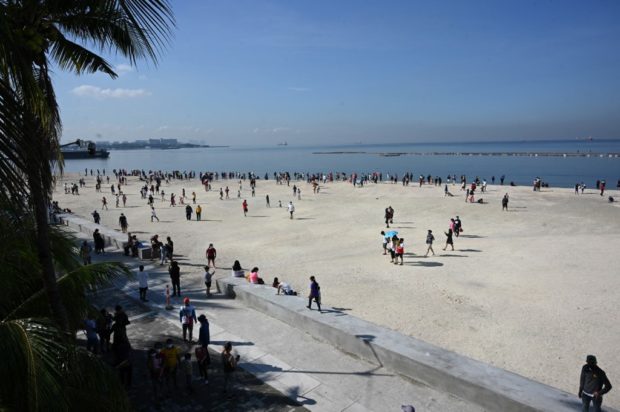
A general view of people trooping to the Manila baywalk dolomite beach along Roxas boulevard in Manila city on October 17, 2021, a day after authorities eased its quarantine restrictions in the nation’s capital. (Photo by TED ALJIBE / AFP)
MANILA, Philippines — Most cinemas nationwide may still be shuttered, but thousands of Filipinos have been enjoying an unexpected blockbuster: Manila Baywalk Dolomite Beach.
The artificial beach was completed like your average thriller, starting off as a controversial, costly makeover of the polluted waterfront and continuing to a mishap-riddled launch — from tons of dolomite sand washing off under heavy rains to a bungled place marker—that became the stuff of derisive memes.
Now worried about the throngs crowding the beach even as Manila is still on alert against COVID-19, the Department of Environment and Natural Resources (DENR) on Tuesday slapped it with a “PG-12” rating.
This means that children younger than 12, and who are not yet covered by the government’s vaccination program, are banned from the premises.
‘Cinema approach’
The move is part of the DENR’s “cinema approach” to crowd control, Environment Undersecretary Jonas Leones said in a press conference.
“Public acceptance has been surprisingly overwhelming through the thousands of people trooping to the dolomite beach since we opened last Oct. 16 to the present. [But] we are aware that if this situation continues, this may bring us to a scenario of a possible superspreader event,” he said.
Leones said that in recent days, “over 18,000” had visited the 1.2-hectare beach. It saw “super visitor surges” last weekend, according to Manila Bay Coordinating Office deputy executive director Jacob Meimban.
There were 63,000 visitors on Saturday, and 121,000 on Sunday, based on their records.
But starting this week, the Manila Bay Task Force will limit the number of visitors to 4,000 to 5,000, and only for two hours each until 6 p.m., Leones said.
To implement this plan, the DENR is considering distributing visitor stubs to mark each batch.
“For example, we open up the dolomite area at 5:30 a.m. They’ll be given two hours to enjoy the scenery, and then … we’ll ask them to leave. We’ll prepare the area again for one hour, and then we’ll allow another batch to enter,” he said.
The DENR will also close down the area on Oct. 29 to Nov. 3, in accordance with the government advisory to control crowds in public places during the All Saints Day holidays.
No IDs needed
But even with these new crowd control measures, the task force will not require visitors to present identification cards, or even vaccination cards, Leones said.
He admitted that the task force did not ban children when it first opened the beach, because the Metro Manila Council had allowed minors to go out in open, public areas.
“But now, since our attention was called by the Office of the President and the IATF, we agreed to ban the minors, consistent with their directive,” he said.
Leones also said the beach would be closed every Friday starting this week for maintenance and rehabilitation work on the bay’s water quality.
He acknowledged that the task force had yet to achieve its target goals to improve the water quality in the heavily polluted bay, with issues of garbage and leaks from waste treatment plants still unaddressed.
The DENR is among the agencies mandated by the Supreme Court to clean up and save the historic bay from pollution. Last year, it started pouring dolomite sand over the bay’s naturally gray shoreline as part of its beach nourishment project under the Manila Bay Rehabilitation Program.
It drew heavy flak from environment groups, which pointed out that the project did not have an environmental compliance certificate before it was implemented.